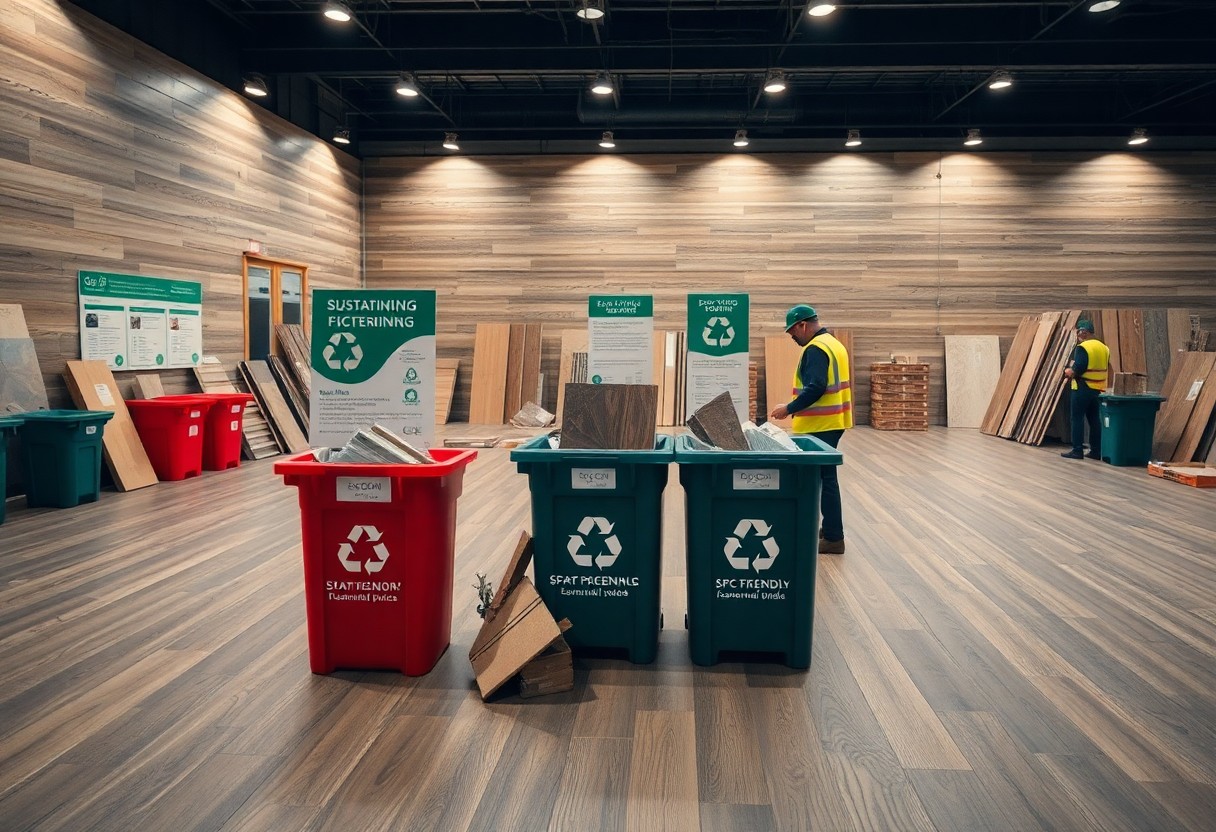Most homeowners today are looking for ways to reduce their environmental impact while maintaining stylish and durable flooring. By choosing laminate and SPC vinyl flooring for your installation, you can make eco-friendly choices that contribute to a more sustainable lifestyle. This blog post will guide you through the sustainable practices involved in Giant Flooring installation, highlighting the benefits of these materials and how they align with your commitment to environmental responsibility. Let’s explore how you can enhance your home with flooring that is both beautiful and environmentally friendly.
Rethinking Flooring: The Environmental Impact of Traditional Practices
It’s time to reconsider our approach to flooring installation and the subsequent environmental consequences tied to traditional practices. Conventional flooring options, including hardwood and carpet, often rely on resource-intensive processes that contribute to deforestation, pollution, and increased waste. As individuals and businesses seek eco-friendly alternatives, understanding the broader impact of materials and installation methods becomes important in making more responsible choices.
Carbon Footprint Analysis of Conventional Flooring
The carbon footprint of conventional flooring materials can be significant, accounting for up to 30% of a building’s total embodied carbon. For example, the harvesting and manufacturing of hardwoods often involve heavy machinery and fossil fuels, leading to greenhouse gas emissions. Moreover, synthetic carpets release volatile organic compounds (VOCs) during production and installation, contributing to air pollution and health issues. By choosing sustainable flooring solutions like laminate or SPC vinyl, you can significantly lower your carbon footprint.
The Role of Flooring in Sustainable Construction
Flooring plays a pivotal role in sustainable construction, acting as a foundational element that influences both environmental impact and building efficiency. Eco-friendly materials contribute to energy savings and improved indoor air quality, which are important factors for wellness. By selecting products with low emissions and high durability, you enhance building performance while reducing the need for frequent replacements. For instance, SPC vinyl often comes with a longer lifespan than traditional flooring, minimizing waste and requiring fewer resources over time.
The Rise of Eco-Friendly Materials: Laminate vs. SPC Vinyl
As sustainability becomes a priority in home renovations, eco-friendly flooring materials like laminate and SPC vinyl are on the rise. These alternatives not only offer aesthetic versatility but also come with environmentally responsible attributes. Both materials utilize advanced technology and processes to reduce waste and enhance energy efficiency, appealing to consumers who desire stylish options that align with their values.
Production Process: Eco-Friendly Innovations
The production of laminate and SPC vinyl has evolved significantly to embrace eco-friendly innovations. Many manufacturers use recycled materials in their compositions, such as post-consumer wood fibers for laminate, and limestone dust combined with PVC for SPC. These selections not only conserve resources but also cut down on harmful emissions during production. Environmentally-conscious brands even seek certifications like GREENGUARD, ensuring their products contribute to healthier indoor air quality.
Durability and Life Cycle Assessment of Laminate and SPC Vinyl
Considering durability, both laminate and SPC vinyl exhibit impressive long-lasting performance. Laminate typically offers a lifespan of 15 to 25 years, while SPC vinyl can last up to 30 years or more due to its rigid core structure. A life cycle assessment highlights that while both materials can outlast traditional flooring options, the more extended lifespan of SPC vinyl often results in less frequent replacements, further reducing overall environmental impact.
When exploring the durability and life cycle of laminate and SPC vinyl, it’s necessary to assess not only their longevity but also the environmental ramifications. SPC vinyl, with its robust composition, is less susceptible to water damage compared to laminate, making it ideal for high-moisture areas. This durability means homeowners may invest less over time in repairs or replacements, making SPC a more sustainable choice. Moreover, both options can be recycled at the end of their lifespan, minimizing landfill contributions and enhancing their eco-friendly appeal.
Installation Techniques that Minimize Waste
Implementing specific installation techniques can significantly reduce waste during your flooring project. By utilizing innovative strategies, you can ensure that your installation not only enhances your living space but also contributes to a more sustainable environment. These methods focus on precision, efficiency, and responsible material management, which ultimately lead to less environmental impact and a cleaner job site.
Precision Cut Methods for Material Conservation
Adopting precision cut methods allows you to maximize the use of every plank and tile while reducing offcuts. Techniques like double cuts and template-based planning help you visualize and strategize your layout, ensuring you use the necessary materials effectively. This level of detail not only brings aesthetic benefits but also minimizes wasted materials, further supporting eco-friendly flooring practices.
Employing Recyclable Tools and Tools with Low Environmental Impact
Using tools designed for sustainability can realign your flooring installation with eco-positive values. Many modern tools are crafted from recyclable materials or specifically designed to use less energy, which reduces your carbon footprint while working on projects. From saws to drills, choosing tools that emphasize recyclability and reduced environmental impact allows you to maintain high standards in both craftsmanship and ecological responsibility.
Employing tools that are recyclable or have low environmental impact represents a significant step towards sustainable flooring projects. For example, battery-operated tools reduce electricity consumption while also providing portability. Additionally, some professional flooring manufacturers offer tools made from partially recycled materials, enhancing their sustainability credentials. The shift towards such eco-friendly tools not only promotes environmental responsibility but can also lead to improved durability and performance, ensuring your installation process remains efficient and effective.
Certification and Standards: Navigating Eco-Friendly Credentials
Identifying eco-friendly flooring products requires understanding the certifications and standards that govern them. Numerous organizations assess sustainability practices, sourcing, and manufacturing processes to grant certifications, ensuring that the products you choose meet environmental guidelines and contribute to a healthier planet. Engaging with these credentials not only adds transparency but also reinforces your commitment to sustainable living as you make informed decisions regarding flooring installation.
Key Certifications for Sustainable Flooring Products
Several imperative certifications signify that your laminate or SPC vinyl flooring adheres to sustainable practices. Look for products that boast the Forest Stewardship Council (FSC) certification, ensuring responsible timber sourcing, and the Greenguard certification, which guarantees minimal emissions of harmful chemicals. Other notable certifications include FloorScore, which evaluates indoor air quality, and SCS Global Services’ certifications that recognize recycled content and other environmental performance benchmarks.
Importance of Eco-Labeling in Consumer Choices
Eco-labeling significantly impacts your decisions when selecting flooring options. Clear, recognized labels assist you in distinguishing environmentally friendly products from conventional ones. In the growing market for sustainable materials, these labels guide you toward choices that align withyour values and priorities, such as reducing carbon footprints and contributing to healthier indoor spaces.
By seeking out eco-labels, you actively participate in driving demand for sustainably produced products. When consumers, like yourself, prioritize eco-friendly options, manufacturers are more likely to adopt sustainable practices to meet this demand. In this way, each informed purchase empowers you to support and promote responsible manufacturing and sourcing, while stimulating a market shift towards greener alternatives in flooring choices.

Transforming Residuals: Responsible Disposal and Recycling
Responsible disposal and recycling of flooring materials play a significant role in reducing waste and promoting sustainability. By implementing effective waste management strategies during installation, you can minimize the environmental impact of your flooring project. This includes sorting excess materials, utilizing designated disposal facilities, and seeking out local recycling options for laminate and SPC vinyl products that have reached the end of their life cycle.
Establishing Recycling Programs for End-of-Life Flooring
Setting up recycling programs for end-of-life flooring materials fosters a circular economy, encouraging manufacturers and consumers to engage in sustainable practices. By working with local waste management authorities, you can ensure that your used laminate and SPC vinyl are collected and processed properly. Supporting such programs not only helps to divert waste from landfills but also promotes the development of new eco-friendly flooring solutions.
The Impact of Upcycling Waste into New Products
Upcycling flooring waste into new products significantly reduces the environmental burden. By transforming scrap laminate and SPC vinyl into new items like furniture, décor, or even new flooring, you contribute to a zero-waste initiative that benefits both the economy and the environment. Innovative companies are making strides to repurpose up to 90% of discarded materials, proving that creativity can turn waste into valuable resources and promote sustainability at every stage of your project.
This approach not only limits the amount of waste that ends up in landfills but also contributes to the creation of unique and sustainable products that appeal to eco-conscious consumers. For instance, flooring offcuts can be repurposed into shelving units or reclaimed into outdoor furniture, leading to a functional second life. By supporting brands focused on upcycling, you’re not just reducing your carbon footprint—you’re also fostering a culture of sustainability that encourages more businesses and individuals to consider the lifecycle of materials from the start to finish.
Final Thoughts on Sustainability in Flooring Choices
Making Informed Decisions
Your flooring choice plays a pivotal role in environmental sustainability. By opting for laminate or SPC vinyl, you align your flooring with eco-friendly practices, as these materials often feature recycled content and low VOC emissions. Moreover, they require less energy to produce compared to traditional wood flooring, minimizing your carbon footprint. Many manufacturers prioritize sustainable sourcing, ensuring that the materials come from responsibly managed forests or recycled sources. Investing in these flooring options not only enhances the aesthetic of your space but also reflects a commitment to environmental stewardship for future generations.

